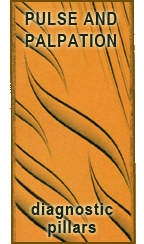Pulse Diagnosis Made Ridiculously Simple (Page 1 of 45)

One qi gong teacher famously suggested that it will take a year to feel your qi, and five years to believe it. In much the same vein, pulse diagnosis is easy to pick up in a few minutes, but it takes somewhat longer to really derive useful diagnostic information.
This lecture has taken many of the ambiguous descriptions of pulses that rely on poetic names and evocative terms and presents them in terms of mostly quantifiable parameters such as width, length, and depth. I hope that this makes pulse diagnosis a little bit easier to wrap your head around.
Because this information is freely distributed online, I assume that these pages will also be accessed by consumers, patients, and other interested parties. At no point should any of the references to internal organs (eg. Spleen, Liver, etc.) be assumed to be the same concept as is usually attributed to these organs in the biomedical mindset.
For instance, when I write about Liver qi, this is best understood as the peripheral or enteric nervous systems. However, Liver blood disharmonies commonly look “hormonal” in conventional biomedicine. Heart blood looks like neurotransmitters. These correspondences are not written in stone. There are too many exceptions to all of these things to make any one-to-one relationships between Chinese medicine concepts and biomedical “realities”.
Next, to properly access a pulse, you will have to be calibrated by someone modalert waklert there with you passing on what a wide pulse feels like compared to a thin pulse. I suppose that after some time and effort, you may be able to arrive at your own calibration if you take enough pulses, but most consumers or patients really aren’t in a position to achieve that goal. As for the more tactile sensations such as the wave forms, this absolutely requires someone showing you exactly what that means so you can then recognize it in other pulses.
So if you’re a consumer, patient, or student, please read these pages with the understanding that you’re missing about half of this course which is the practical action of taking pulses and discussing their diagnostic findings with a more experienced practitioner.
Lecture Sources:
- Traditional Chinese Medicine Diagnosis Study Guide
by Yi Qiao, L.Ac., and Al Stone, L.Ac., DAOM. Majority of lecture. - Practical Diagnosis in Traditional Chinese Medicine
(Churchill Livingstone 1999) Tietao Deng. Ergil, Sumei (translators), the other Ergil (editor). - Alisms – stuff I’ve noticed. Alisms are always designated as such. Being in practice for 12 years is not enough time to go off and teach my own doctrine, however I have learned a thing or three and would like to pass them on. Feel free to give “alisms” somewhat less weight than the more distinguished sources.
Next: The Educational Benefits of Pulse Quality Mechanisms.
 Last modified: August 27, 2009
Last modified: August 27, 2009  Tags: Diagnosis, Palpation, study guide В· Posted in: Pulse Class, Pulse-Palpation
Tags: Diagnosis, Palpation, study guide В· Posted in: Pulse Class, Pulse-Palpation
